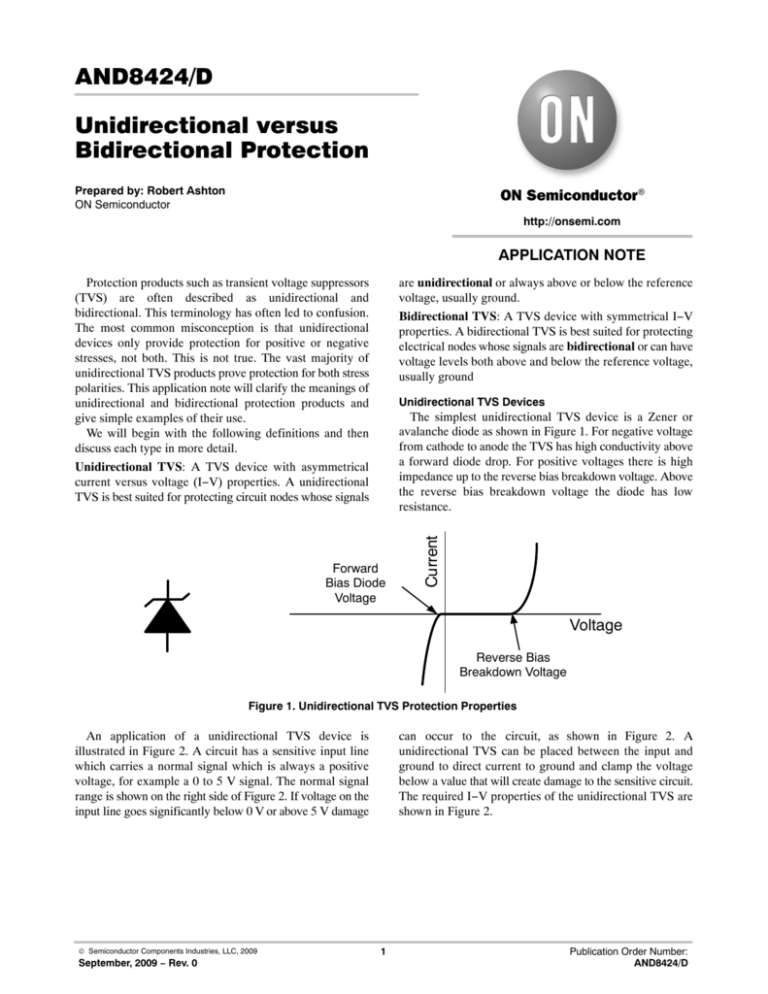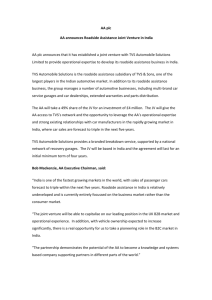AND8424 - Unidirectional versus Bidirectional Protection
advertisement

AND8424/D Unidirectional versus Bidirectional Protection Prepared by: Robert Ashton ON Semiconductor http://onsemi.com APPLICATION NOTE are unidirectional or always above or below the reference voltage, usually ground. Bidirectional TVS: A TVS device with symmetrical I−V properties. A bidirectional TVS is best suited for protecting electrical nodes whose signals are bidirectional or can have voltage levels both above and below the reference voltage, usually ground Protection products such as transient voltage suppressors (TVS) are often described as unidirectional and bidirectional. This terminology has often led to confusion. The most common misconception is that unidirectional devices only provide protection for positive or negative stresses, not both. This is not true. The vast majority of unidirectional TVS products prove protection for both stress polarities. This application note will clarify the meanings of unidirectional and bidirectional protection products and give simple examples of their use. We will begin with the following definitions and then discuss each type in more detail. Unidirectional TVS: A TVS device with asymmetrical current versus voltage (I−V) properties. A unidirectional TVS is best suited for protecting circuit nodes whose signals Unidirectional TVS Devices Forward Bias Diode Voltage Current The simplest unidirectional TVS device is a Zener or avalanche diode as shown in Figure 1. For negative voltage from cathode to anode the TVS has high conductivity above a forward diode drop. For positive voltages there is high impedance up to the reverse bias breakdown voltage. Above the reverse bias breakdown voltage the diode has low resistance. Voltage Reverse Bias Breakdown Voltage Figure 1. Unidirectional TVS Protection Properties can occur to the circuit, as shown in Figure 2. A unidirectional TVS can be placed between the input and ground to direct current to ground and clamp the voltage below a value that will create damage to the sensitive circuit. The required I−V properties of the unidirectional TVS are shown in Figure 2. An application of a unidirectional TVS device is illustrated in Figure 2. A circuit has a sensitive input line which carries a normal signal which is always a positive voltage, for example a 0 to 5 V signal. The normal signal range is shown on the right side of Figure 2. If voltage on the input line goes significantly below 0 V or above 5 V damage © Semiconductor Components Industries, LLC, 2009 September, 2009 − Rev. 0 1 Publication Order Number: AND8424/D AND8424/D Current Input Sensitive Circuit Normal Signal Range Device Damage Vinput Device Damage Unidirectional TVS I−V GND Figure 2. Application of a Unidirectional TVS Device positive and negative voltage the impedance is high up to the reverse bias breakdown voltage plus a forward bias diode drop. This is shown on the right side of Figure 3. Note that for circuit nodes whose voltage is always below the reference voltage a unidirectional device can provide protection simply by switching the terminal leads. Bidirectional TVS Devices Current A simple example of a TVS device is a pair of back to back Zener or avalanche diodes, as shown in Figure 3. For both or Voltage Reverse Breakdown Voltage Plus Forward Diode Drop Figure 3. Bidirectional Protection Properties can occur to the circuit, also shown in Figure 4. A bidirectional TVS can be placed between the input and ground to direct current to ground, clamping the voltage below voltages that can cause damage. The required I−V properties of the bidirectional TVS are shown in Figure 4. An application of a bidirectional TVS device is illustrated in Figure 4. A circuit has a sensitive input line which carries a normal signal which ranges symmetrically above and below ground, $12 V for example. The normal signal range is shown on the right side of Figure 4. If voltage on the input line goes significantly below −12 V or above +12 V damage http://onsemi.com 2 AND8424/D Sensitive Circuit Current Input Device Damage Normal Signal Range Normal Signal Range Device Damage Vinput Bidirectional TVS I−V GND Figure 4. Application of a Bidirectional TVS Device Summary power nodes with unidirectional signal swings and bidirectional TVS products protect signal or AC power nodes with bidirectional signal swings. The choice of a unidirectional or bidirectional TVS product depends on the properties of the circuit being protected. Unidirectional TVS products protect signal or DC ON Semiconductor and are registered trademarks of Semiconductor Components Industries, LLC (SCILLC). SCILLC reserves the right to make changes without further notice to any products herein. SCILLC makes no warranty, representation or guarantee regarding the suitability of its products for any particular purpose, nor does SCILLC assume any liability arising out of the application or use of any product or circuit, and specifically disclaims any and all liability, including without limitation special, consequential or incidental damages. “Typical” parameters which may be provided in SCILLC data sheets and/or specifications can and do vary in different applications and actual performance may vary over time. All operating parameters, including “Typicals” must be validated for each customer application by customer’s technical experts. SCILLC does not convey any license under its patent rights nor the rights of others. SCILLC products are not designed, intended, or authorized for use as components in systems intended for surgical implant into the body, or other applications intended to support or sustain life, or for any other application in which the failure of the SCILLC product could create a situation where personal injury or death may occur. Should Buyer purchase or use SCILLC products for any such unintended or unauthorized application, Buyer shall indemnify and hold SCILLC and its officers, employees, subsidiaries, affiliates, and distributors harmless against all claims, costs, damages, and expenses, and reasonable attorney fees arising out of, directly or indirectly, any claim of personal injury or death associated with such unintended or unauthorized use, even if such claim alleges that SCILLC was negligent regarding the design or manufacture of the part. SCILLC is an Equal Opportunity/Affirmative Action Employer. This literature is subject to all applicable copyright laws and is not for resale in any manner. PUBLICATION ORDERING INFORMATION LITERATURE FULFILLMENT: Literature Distribution Center for ON Semiconductor P.O. Box 5163, Denver, Colorado 80217 USA Phone: 303−675−2175 or 800−344−3860 Toll Free USA/Canada Fax: 303−675−2176 or 800−344−3867 Toll Free USA/Canada Email: orderlit@onsemi.com N. American Technical Support: 800−282−9855 Toll Free USA/Canada Europe, Middle East and Africa Technical Support: Phone: 421 33 790 2910 Japan Customer Focus Center Phone: 81−3−5773−3850 http://onsemi.com 3 ON Semiconductor Website: www.onsemi.com Order Literature: http://www.onsemi.com/orderlit For additional information, please contact your local Sales Representative AND8424/D



